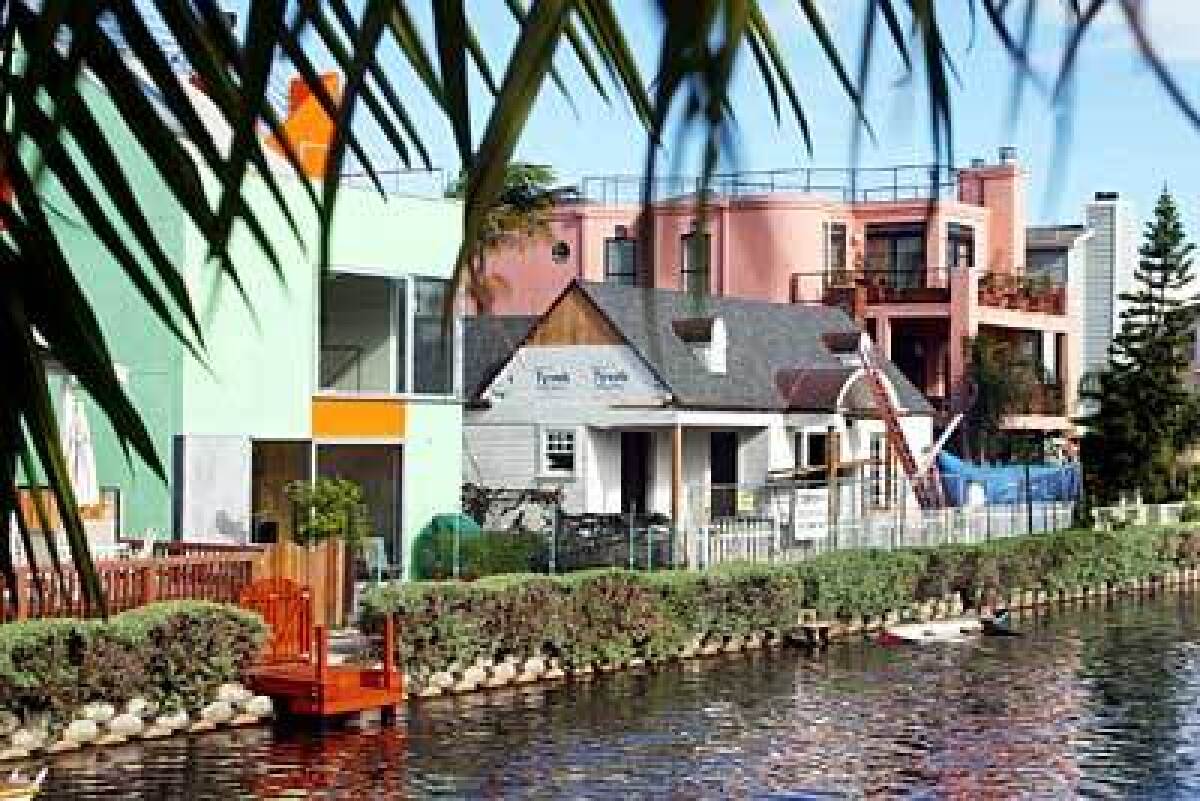The renaissance of Venice

- Share via
Envisioned as a replica of the Italian city, the Venice canal area is a fraction of the original L.A. network. Less than two miles of its canals remain, lined with cozy bungalows and massive newer houses. The mix of styles offers a glimpse of the ebbs and flows the community has seen since its opening a century ago.
Background
Wealthy businessman Abbott Kinney and a partner purchased a tract of land 1 1/2 miles long and 1,000 feet deep along the Pacific in 1891. Between Santa Monica and Marina del Rey, the property included a controlling interest in Ocean Park Casino and Resort.
Kinney dreamed of creating a fabulous city modeled after Venice, Italy. After dissolving his partnership, Kinney was considered foolish by some for picking a swampy sand dune area to develop his dream. Although the project was dubbed “Kinney’s Folly,” he shrugged off detractors and hired Frank Durham as building superintendent to create his Venice of America beach resort.
Sixteen miles of canals served as a means of transportation and recreation. Gondolas were imported from Italy, and boatmen sang as they paddled along the canals. Since cars were still a luxury in the early 1900s, few roads were built. For commuters, electric trolley cars provided service to downtown Los Angeles. The business district, modeled after the Piazza San Marco in Venice, Italy, was placed away from the residential canal area.
Officially opened in 1905, the project seemed an instant success. By the 1920s, however, inadequate roads and parking had sparked frustration among residents and visitors.
The local government also fell into disrepair, so in 1925, the area became part of the city of Los Angeles. A proposal was launched to fill in some of the canals and turn them into streets.
After years of wrangling between Venice property owners and city officials, the California Supreme Court ruled that Los Angeles had the power to fill in some of the canals. In the summer of 1929, as several residents stood by in protest, equipment was brought in to start the job. Residents were distressed as their lovely Coral Canal was drained, filled with dirt and named Main Street. All but six canals were turned into paved streets and renamed.
After the dust settled, the remaining Venice canals and immediate neighborhood was bounded by Pacific Avenue to the west, Ocean Avenue to the east, Washington Boulevard on the south and Venice Boulevard to the north.
Drawing card
Homes in the canal area face the water, with garages in common rear alleys. Several pedestrian bridges provide access over the canals, and there are four vehicular bridges.
Insider’s view
“There’s a nice mix of neighbors here, ranging from former hippies to corporate executives,” said resident Beverly Weise. “It’s a wonderful group of people.”
Decay and renewal
The late 1960s saw a serious decline in the canal area. The waterways had deteriorated into stagnant, dirty pools with crumbling banks. Properties fell into disrepair.
In the early 1990s, the city began restoration work. The project included new sidewalks and landscaping that runs the course of the canals, plus renewed bridges and sturdy canal banks.
Soon after, the area experienced a revival, with new construction and home renovation. Coldwell Banker Realtor and resident Sandy Berens noted, “Prices increased greatly after the canal renovation.”
Stock report
Homes fronting the six canals number about 370. Closely arranged, the lots are small, averaging about 2,400 square feet. Some of the original Craftsman bungalows measure less than 600 square feet.
Newer homes are usually large, sometimes topping three floors in height. A newly built Mediterranean-style home with slightly less than 4,000 square feet of living space on a 2,848-square-foot lot recently sold for $2,150,000.
On the market
Two homes for sale on the canals, both with three bedrooms and built in the 1970s, are priced at $1,495,000 and $1,739,000. Recent sales reflect the diverse assortment of residences, ranging in price from a tiny 1920s bungalow for $800,000 to a Japanese-inspired mansion of just under 3,000 square feet for $2,425,000.
Report card
Opened in 1926, Coeur D’Alene Avenue School is the local grade school. On the 2004 Academic Performance Index, it scored 826 out of a possible 1,000. Mark Twain Middle School students scored 581, and Venice High School tallied 645. All schools are part of the Los Angeles Unified School District.
Historical values
Residential resales for the entire 90291 ZIP Code:Year...Median Price
1990...$315,0001995...$210,000
2000...$394,000
2003...$520,000
2004*...$776,000
*Through NovemberSources: DataQuick Information Systems; Los Angeles Unified School District, lausd.k12.ca.us; mls.com; city of Los Angeles Architectural Division; Coldwell Banker Marina del Rey; https://www.laparks.org/venice/venice.htm ; Venice Chamber of Commerce, https://www.venicechamber.net .


